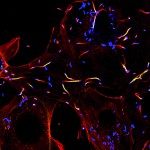Lien vers Pubmed [PMID] – 24910634
Front Immunol 2014;5:254
The biological activities of human IgG antibodies predominantly rely on a family of receptors for the Fc portion of IgG, FcγRs: FcγRI, FcγRIIA, FcγRIIB, FcγRIIC, FcγRIIIA, FcγRIIIB, FcRL5, FcRn, and TRIM21. All FcγRs bind IgG at the cell surface, except FcRn and TRIM21 that bind IgG once internalized. The affinity of FcγRs for IgG is determined by polymorphisms of human FcγRs and ranges from 2 × 10(4) to 8 × 10(7) M(-1). The biological functions of FcγRs extend from cellular activation or inhibition, IgG-internalization/endocytosis/phagocytosis to IgG transport and recycling. This review focuses on human FcγRs and intends to present an overview of the current understanding of how these receptors may contribute to various pathologies. It will define FcγRs and their polymorphic variants, their affinity for human IgG subclasses, and review the associations found between FcγR polymorphisms and human pathologies. It will also describe the human FcγR-transgenic mice that have been used to study the role of these receptors in autoimmune, inflammatory, and allergic disease models.


